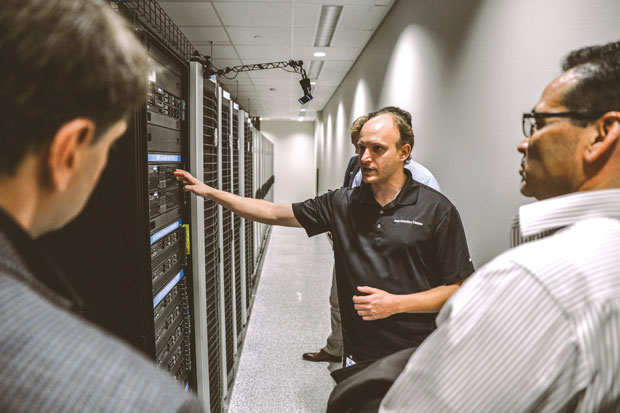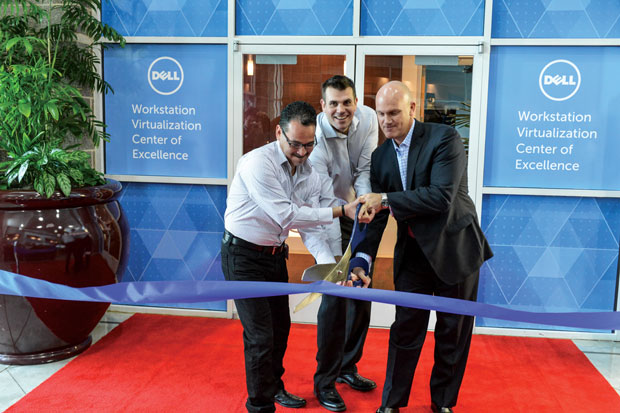Dell Advances Virtual Workstation Adoption

Behind the scenes at the Dell Workstation Virtualization CoE. Image courtesy of Dell.
Latest News
July 1, 2015
 Cutting the ribbon at the Dell Workstation Virtualization Center of Excellence in Round Rock, TX. Image courtesy of Dell.
Cutting the ribbon at the Dell Workstation Virtualization Center of Excellence in Round Rock, TX. Image courtesy of Dell.When Dell first launched the Dell Workstation Virtualization Center of Excellence (CoE) last year, it was with the intention of exposing customers to the next generation of workstation computing. However, Dell’s original CoE, which is located at the Dell Solutions Center in Round Rock, TX, spawned multiple ideas, case studies and new HPC (high-performance computing) ideologies, all of which showed the benefits of moving workstation chores into the virtual realm. What’s more, the initial success of the Round Rock-based CoE led to the creation of additional CoE labs, with a second CoE launched in Limerick, Ireland. The Ireland location allows Dell to work more closely with ISVs (independent software vendors) and customers based in Europe to better demonstrate decentralized workstation load processing across multiple CoE labs.
Dell’s CoE sites offer full support for remote customers to carry out performance benchmarking, conduct subjective user-assisted testing and choose the right endpoint devices and monitors before leaping into the world of virtualized workstation solutions.
“We are seeing a change in the way users of data and graphics intensive applications are able to securely access their data outside of the office. The idea of the fixed location-based workstation has changed as users need to be mobile and collaborate efficiently with others both within and outside of their organization,” says Andy Rhodes, executive director, Dell Precision. “Furthermore the notion of a 1:1 relationship between a user and a piece of hardware is going away, as an increasing number of IT managers see desktop virtualization as a viable means of providing users with a secure, manageable and resource efficient way to access their desktops and applications.”
Dell’s CoE concepts have offered immediate benefits to customers delving into virtual workstation architectures. However, Dell has also gained insight from operating the CoE. For example, the CoE has been instrumental in helping Dell build reference architectures for the Dell Wyse Datacenter for Virtual Workstations. “Those reference architectures should save our customers countless hours of deployment time,” says Gary Radburn, head of Workstation Virtualization at Dell.
“The CoE has proven to be a major success and on numerous occasions has allowed our customers to experience a virtual workstation environment, without any upfront expense. Customers have also been able to work with major ISVs to prototype software solutions, test scalability of workstation applications and develop proofs of concept before making any major purchases,” Radburn says.
ISV usage of the CoE has proven to be an effective and instrumental capability. “This is the first time a major technology company has worked closely with the ISV community, on behalf of the customer, to bring validated solutions to market in the form of reference architectures that can be readily deployed and easily scaled to meet varied customer needs within virtual environments,” says Radburn.
Dell has released, tested and certified configurations for workstation-class applications for Siemens PLM Software, as well as reference configurations for Autodesk, PTC and Dassault Systemes. Organizations can deploy the reference architectures on Dell Precision R7610 rack workstations or Dell PowerEdge R720 rack servers with NVIDIA GRID K1 or K2 graphic cards on the VMware Horizon View and Citrix XenDesktop platforms.
ISVs Flock to the CoE
The CoE provides ISVs with a simplified way to compatibility test and certify existing applications for virtual workstation environments, and evolve their offerings to leverage the benefits of the new technology in this area.“Dell’s Center of Excellence for virtual desktops will be an invaluable resource for both Siemens PLM Software and our customers,” said Paul Brown, senior marketing director, Siemens PLM Software. “We’ve completed certifications of our NX software on a variety of virtual configurations helping to provide our customers with deployment options to future proof their architecture. Our customers can duplicate and test their planned configuration to confirm the hardware and software environment meets their requirements.”
Dell is also working with several other ISVs to develop reference architectures, including Autodesk, PTC and Dassault Systemes, each of which are looking to move workstation-class applications into the world of virtual workstations.
“Design and engineer professionals are more mobile and distributed than ever before and they are working on projects with ever increasing complexity. These projects teams need the ability to access critical design data from anywhere and at any time,” said Ben Cochran, senior architect for Platform Products, Autodesk. “Virtualization solutions give designers and engineers the flexibility, security and power to run sophisticated 3D design applications such as AutoCAD, Inventor, Revit or 3ds Max on virtually any device, or via a Web browser. We are excited that Dell is providing a virtualization solution targeted at our professional customers.”
A Cloudy Future for Workstations?
Although workstation prices have fallen over the last few years making them ever more affordable, there are still major driving factors for engineering-type businesses to move to a virtual architecture. Those issues include mobility, efficiency and ultimately, total cost of ownership.
The innovations flowing out of Dell’s CoE are helping to redefine the engineer/workstation relationship. One of those innovations comes by maximizing hardware usage. “We have developed reference systems that allow organizations to do design chores during regular business hours, and then basically flip a switch to run intensive simulations during the off hours, all on the same hardware,” says Radburn. That capability is further fueled by the concept of cloud access to HPC systems, which are built upon virtualized workstation infrastructures.
What’s more, Dell is designing dedicated server class hardware to drive workstation virtualization ahead—case in point is Dell’s Precision Rack 7910 XL, a 2U rack mountable workstation that is optimized for ESX and Citrix environments. Options include AMD FirePro, NVIDIA Quadro, Grid and Tesla GPUs.
The ability to leverage reference architecture allows organizations to rapidly move over to a virtual workstation infrastructure, which democratizes access to workstation level performance. Other notable advances will come in the form of “workstations as a service,” where MSPs (managed service providers) can build remotely accessible datacenters built on Dell’s Wyse Datacenter for Virtual Workstations architecture. Those MSPs can then lease workstation access to customers, allowing them to scale up and down as needed, with little or no upfront expenses.
The Dell Wyse Datacenter for Virtual Workstations architecture enables engineers and designers to run demanding workloads remotely, bringing geographic flexibility to those working beyond traditional office environments. What’s more, remote access can be combined with BYOD (bring your own device) programs, which can result in improved workflows as well as significant time savings.
The CoE also exhibits recognizable benefits for those charged with managing IT resources, thanks to its centrally hosted and managed graphics environment. IT managers are able to more efficiently deploy high-end workloads and use IT resources more effectively while ensuring data integrity and efficient failover. Other benefits of cloud-accessible virtualized workstations include the ability to share a centralized data set, which should boost productivity and create secure collaboration opportunities with third parties. Simply put, the CoE demonstrates that Dell Wyse Datacenter for Virtual Workstations’ architecture allows users from across the globe to remotely access the same data and applications on an as-needed basis.
Making the Virtual Leap
For those who doubt the viability of a virtualized workstation infrastructure, Dell simply points to the successes of VDI (Virtual Desktop Infrastructure), which serves as a viable example for moving compute resources into the cloud.
“Desktop Virtualization has long been gaining popularity in the enterprise as a means to securely deploy applications to users both in the office and working remotely,” said Steve Lalla, general manager and vice president, Cloud Client Computing, Dell. “We are delighted to be working closely with our partners Citrix and VMware on extending virtualized desktops to those users requiring high performance solutions with the additional flexibility to use the tools of their job wherever and whenever they choose.”
More Info
Subscribe to our FREE magazine, FREE email newsletters or both!
Latest News
About the Author
Frank OhlhorstFrank Ohlhorst is chief analyst and freelance writer at Ohlhorst.net. Send e-mail about this article to [email protected].
Follow DE






